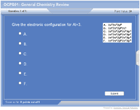General Chemistry Review
| Topic Review on "Title": |
Atomic and Molecular Structure
The number of protons is equal to the atomic number. The number of neutrons is equal to the mass number minus the atomic number. The number of electrons is equal to protons, if neutral. From the number of electrons, determine the electronic configuration, following the arrow from the bottom. The s orbital has two electrons; the p orbital has six electrons; the d orbital has ten electrons; and the f orbital has fourteen electrons. The valence electrons are the number of electrons in the outer shell. Isotopes have the same number of protons, but a different number of neutrons. Ions have lost or gained electrons. Cations have lost electrons. Anions have gained electrons. Radicals have no loss or gain of electrons and have a single electron. Lewis structures are drawn using the valence electrons. Formal charge = [number of valence electrons] B [nonbonding electrons] - 0.5 [bonding electrons].
Types of Carbon Molecules
A stable neutral molecule has not gained or lost electrons. A carbanion has gained electrons. A carbocation has lost electrons. A radical is neutral and has a single electron.
Intermolecular Bond Interactions
Electronegativity is defined as an atom=s ability to attract electrons. Electronegativity increases from left to right on the periodic table. Electronegativity increases from bottom to top on the periodic table. Fluorine is the most electronegative atom. Carbon and hydrogen have approximately the same electronegativity. Bond polarity occurs when the bonding electrons are not shared equally in a covalent bond. The most electronegative atom is labeled with a _- and the least electronegative atom is labeled with a _+. For bonds, an arrow is drawn toward the most electronegative atom, with the arrow drawn to nonbonding electron pairs. The dipole is the separation of charge between two covalently bonded atoms. The dipole moment is the sum of the individual dipoles. Ionic bonding is the transfer of electrons. Covalent bonding is the sharing of electrons. Polar covalent bonding is covalent bonding between atoms of different electronegativity. Nonpolar covalent bonding is covalent bonding between atoms of the same electronegativity. In a homolytic cleavage, each fragment gets one electron; radicals are formed. In a heterolytic cleavage, one fragment gets both electrons and the other fragment gets no electrons; ions are formed.
Molecular Orbitals
A sigma bond can occur with the overlap of two s orbitals, one s and one end of one p orbital, or two ends of a p orbital. A pi bond is formed by the side by side overlap of two p orbitals. A single bond contains one sigma bond. A double bond contains one sigma bond and one pi bond. A triple bond contains one sigma bond and two pi bonds. Hybridization can be determined by sigma bonds and nonbonding electron pairs around one atom. An atom with 2 sigma bonds and 0 nonbonding electron pairs is sp hybridized, has a linear shape, and a bond angle of 180o. An atom with 3 sigma bonds and 0 nonbonding electron pairs is sp2 hybridized, has a trigonal planar shape, and a bond angle of 120o. An atom with 4 sigma bonds and 0 nonbonding electron pairs is sp3 hybridized, has a tetrahedral shape, and a bond angle of 109.5o. An atom with 3 sigma bonds and 1 nonbonding electron pairs is sp3 hybridized, has a trigonal pyramidal shape, and a bond angle of 107o. An atom with 2 sigma bonds and 2 nonbonding electron pairs is sp3 hybridized, has a bent shape, and a bond angle of 105o.
Intermolecular Forces
London dispersion forces are forces between nonpolar molecules. Dipole-dipole forces are forces between polar molecules. Hydrogen bonding is between molecules with BOH, -NH, or HF.
|
| Rapid Study Kit for "Title": |
| Flash Movie |
Flash Game |
Flash Card |
| Core Concept Tutorial |
Problem Solving Drill |
Review Cheat Sheet |
 |
 |
 |
|
| "Title" Tutorial Summary : |
Before understanding organic chemistry, atomic structure, electronic configuration, valence electrons, isotopes, ions, radicals, Lewis structures, and formal charges need to be reviewed. Carbon molecules can exist as stable neutral molecules, carbanions, carbocations, or radicals. Intramolecular bond interactions can be explained through electronegativity, bond polarity, bonding, and bond breaking. Bonding can be ionic or covalent. Bond breaking can be homolytic or heterolytic cleavage. Molecular orbitals can be described in terms of sigma bonds, pi bonds, and hybridization. The sp, sp2, and sp3 hybridization will be described and examples given. The three types of intermolecular forces are London dispersion forces, dipole-dipole forces, and hydrogen bonding.
|
| Tutorial Features: |
This tutorial provides the comprehensive coverage of the chapter with easy introduction and simple illustration. It features:
- Concept map showing interconnections of new concepts in this tutorial.
- Definition slides introduce terms as they are needed.
- Visual representation of structures and concepts.
- Compare and contrast of key structures.
- Use of colors to emphasis points.
- Examples worked out step-by-step throughout the tutorial.
- A concise summary is given at the conclusion of the tutorial.
|
| "Title" Topic List: |
Atomic and Molecular Structure
- Atomic Structure
- Electronic Configuration
- Valence Electrons
- Isotopes, Ions, and Radicals
- Lewis Structures
- Formal Charges
Types of Carbon Molecules
- Stable Neutral Molecules
- Carbanions
- Carbocations
- Radicals
Intermolecular Bond Interactions
- Electronegativity
- Bond Polarity
- Bonding (Ionic and Covalent)
- Bond Breaking (Homolytic and Heterolytic)
Molecular Orbitals
- Sigma and Pi Bonds
- Hybridization (sp, sp2, sp3)
Intermolecular Forces
- London Dispersion Forces
- Dipole-dipole Forces
- Hydrogen Bonding
|
See all 24 lessons in college chemistry, including concept tutorials, problem drills and cheat sheets:
Teach Yourself Organic Chemistry Visually in 24 Hours |



